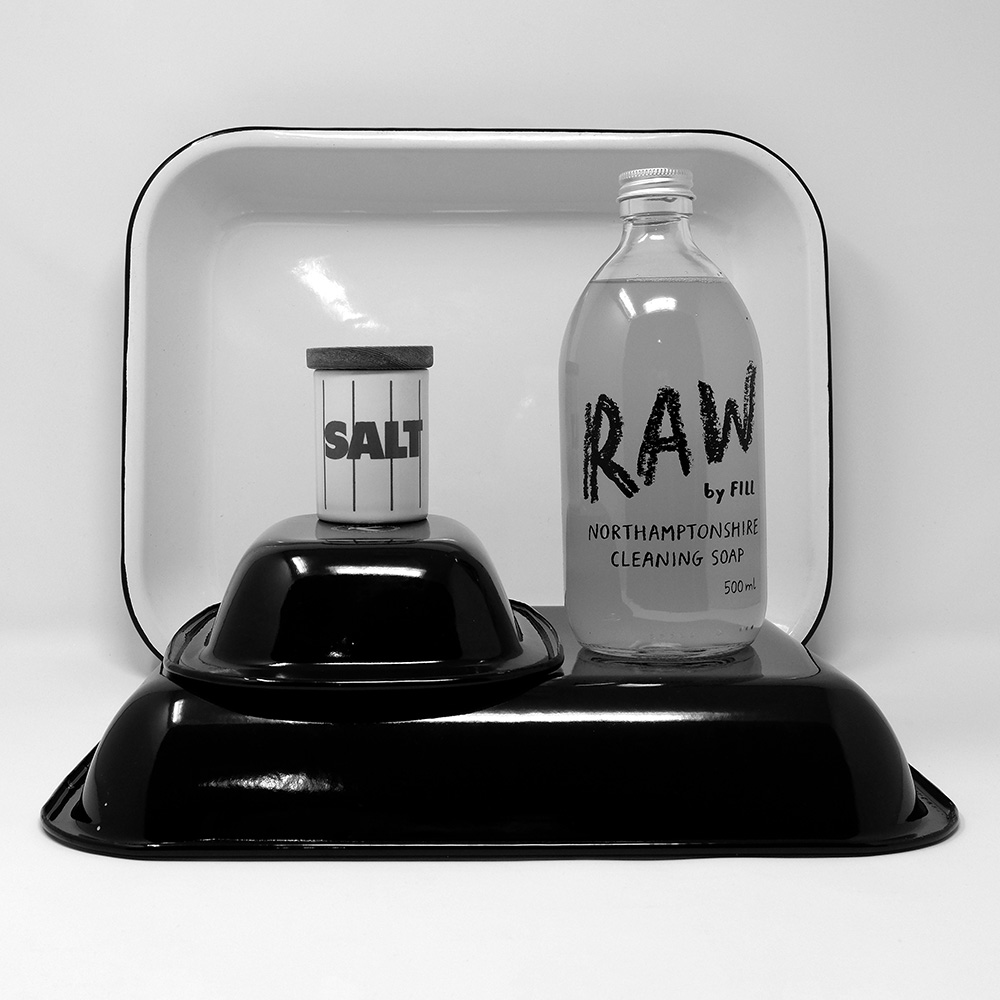We have always firmly believed that a hard day’s work deserves a fair day’s pay. Our team works incredibly hard to produce our Mellow Yellow products to the highest quality, working with expensive equipment and requiring many skills to get the job done. Because of this, we have always paid above the minimum wage and now we are very proud to announce that we have now been certified as a Living Wage Employer!
What is a Living Wage Employer?
In the UK, the National Minimum Wage applies to all those under 23 years of age, and then the National Living Wage applies to all those above 23 years of age. However, this National Living Wage does not take into account the actual, real-world cost of living. So that is where the Living Wage Foundation steps in and each year they calculate the real Living Wage, based on rent, bills, etc.
It applies to all workers over 18, recognising that young people have the same living costs as everyone else. There is also a higher rate for London which takes into account the higher living costs in the capital.
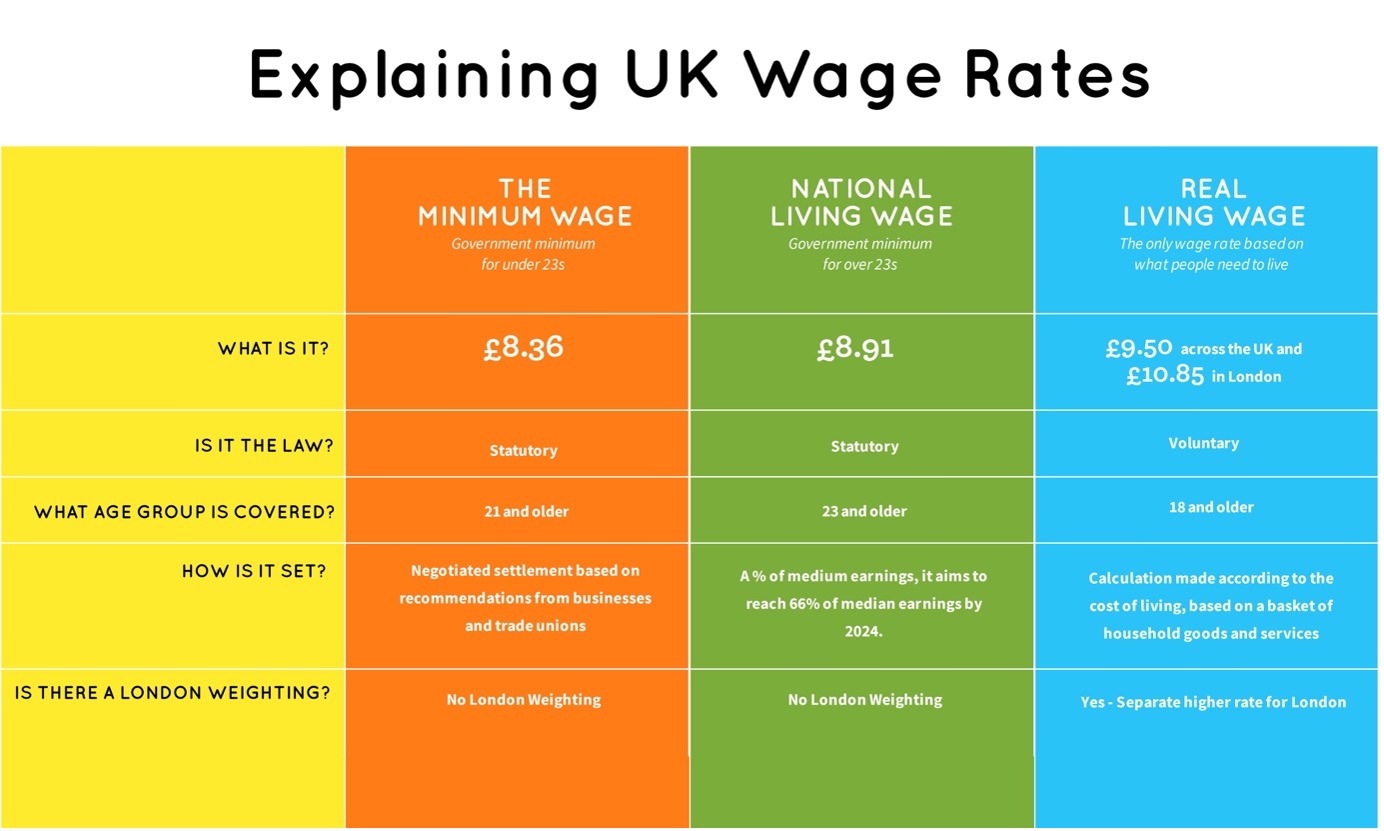
The real Living Wage is independently calculated based on a public consultation method called Minimum Income Standard (MIS). MIS identifies what people need to be able to afford as a minimum. This is fed into a calculation of what someone needs to earn as a full-time salary, which is then converted to an hourly rate.
Why pay the Living Wage?
We firmly believe that all employees deserve a wage which meets everyday needs – like the weekly shop, the electricity bill or a surprise trip to the dentist.
The past year’s pandemic has affected us all, but the poorest have been hit hardest. Two thirds of those earning below the Living Wage saw their pay fall last year, with devastating effects. More than a quarter of those earning below the real Living Wage were forced to regularly skip meals, while nearly half saw a negative impact on their levels of anxiety. Despite the pandemic shining a spotlight on the importance of low paid workers, over 5.5 million continue to earn less than the Living Wage, that’s 20.3% of all workers in the UK not earning a real Living Wage.
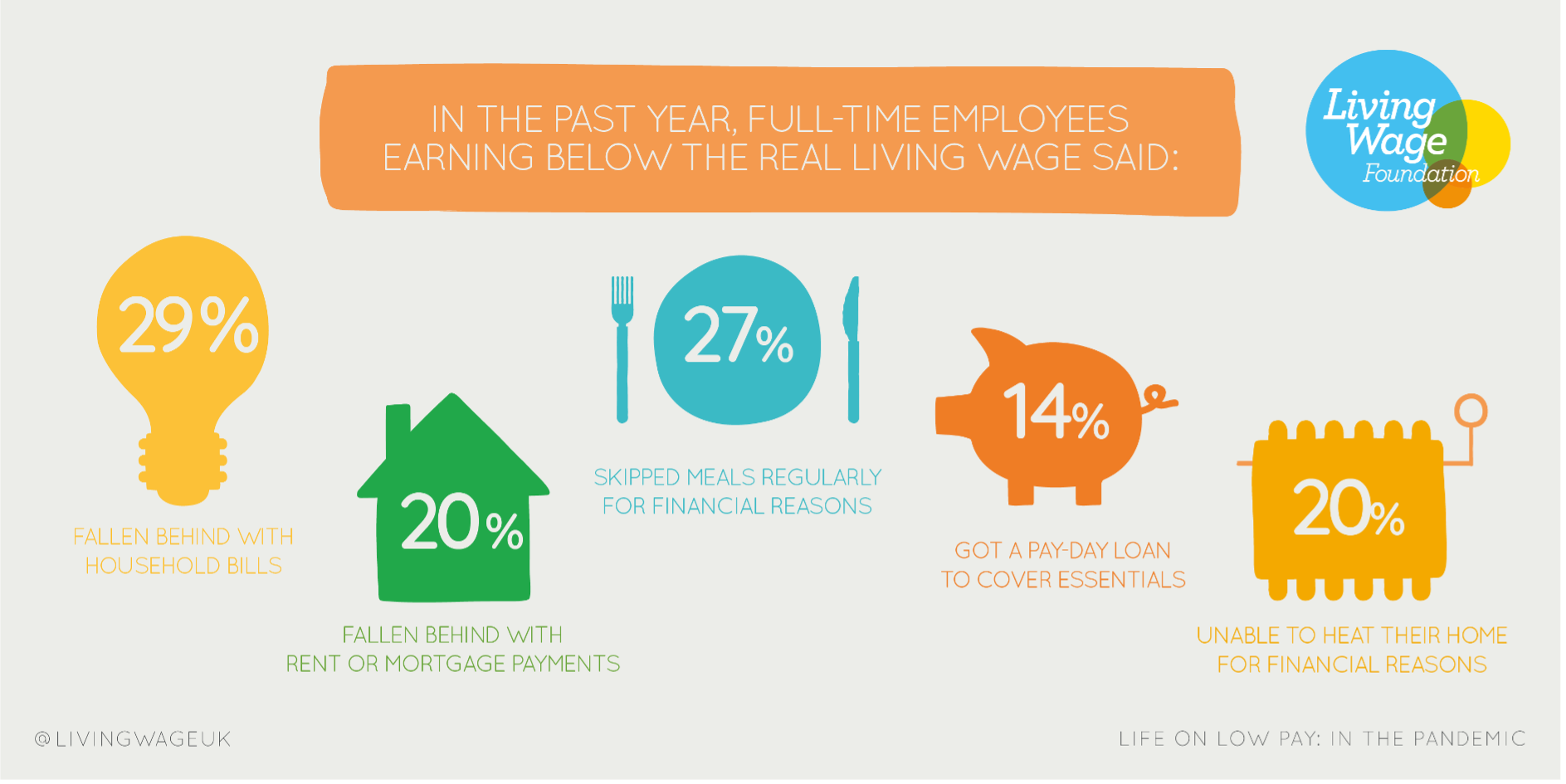
![]() 93% of university graduates want to work for a Living Wage Employer
93% of university graduates want to work for a Living Wage Employer
![]() 93% of the Living Wage network say it has benefitted their business
93% of the Living Wage network say it has benefitted their business
![]() 90% of consumers agree that pay should reflect living costs
90% of consumers agree that pay should reflect living costs
![]() 85% of Living Wage Employers said it has enhanced their reputation as an employer
85% of Living Wage Employers said it has enhanced their reputation as an employer
We are so proud to be a Living Wage Employer, showing our commitment to our employees and our belief that you should be able to earn a wage you can live on.
Who else pays the Living Wage?
The real Living Wage is the only UK wage rate that is voluntarily paid by over 8,000 UK businesses, from major UK corporations to small and medium businesses like us!
You can find Living Wage Employers near you with this map: https://www.livingwage.org.uk/living-wage-map
![]()
Learn more about the real Living Wage here: https://www.livingwage.org.uk/
Around the edges of our fields, there’s something really special; wildflowers. In these wildflower meadow margins, as they are known, we have a huge variety of different plant species, insects and birds, improving biodiversity and creating wildlife habitats. In the summer months, these wildflower meadow margins come alive with the buzzing and fluttering of bees, butterflies and many other insects.
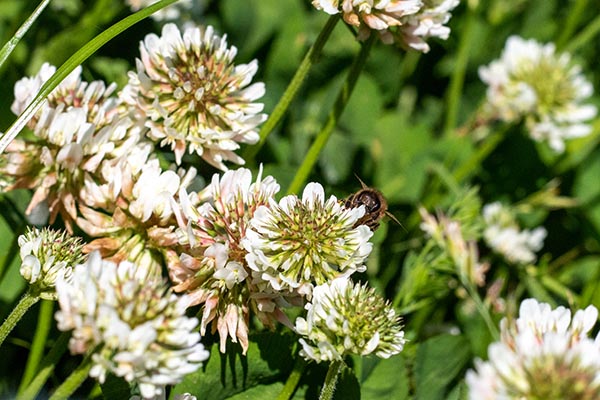
As well as providing habitats for insects and improving biodiversity, our wildflowers also help us out on the farm. The wildflowers attract pollinators, which are essential for crop pollination, plus the insects in the wildflowers act as a natural pest control on our crops.
Did you know that you can bring wildflowers into your own garden too? Set aside an area of lawn, part of a border, or if you are limited on space, a large container will do! Either stop mowing a patch of your lawn to encourage long grass to grow for insects to thrive in, provide shelter for small mammals and create feeding opportunities for birds. Or if you’d rather start from scratch, pick a spot of bare, unproductive soil and sow a wildflower seed mix in autumn, or spring if you have a heavy clay soil, rake the seeds, water thoroughly and wait for a beautiful patch of wildflowers to appear come summer.
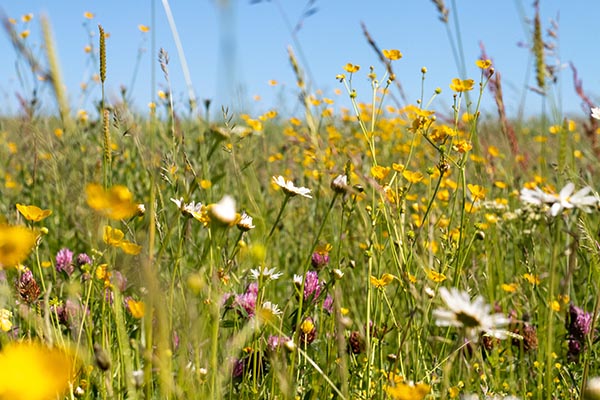
Here we have just some of the wildflowers growing in our wildflower meadow margins:
Oxeye Daisies
These are native daisies but are bigger and taller than the standard daisies you may see in your lawn. The yellow coloured centre of the oxeye daisy is packed full of pollen and nectar and attracts various pollinating insects such as butterflies, bees and hoverflies.
The heads of these plants can also be used to make chamomile tea.
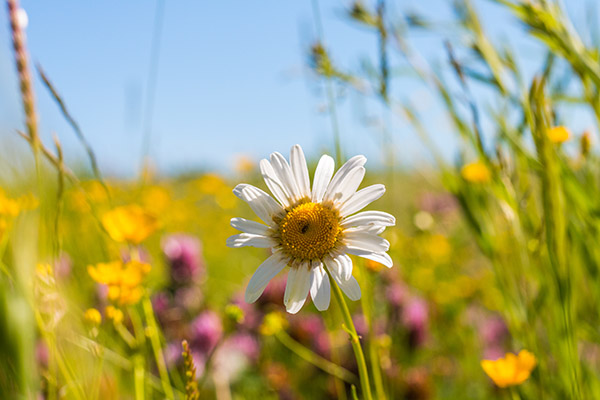
Buttercups
The pretty yellow flowers are buttercups, they are very common in Britain thanks to our moist soils. They flower from May to August and attract flies, beetles and bees including honeybees.
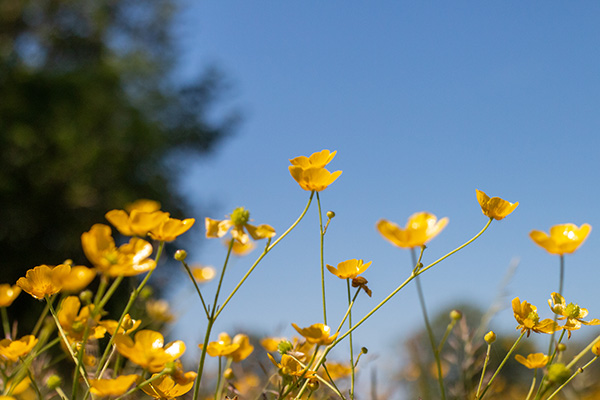
Clover
We have two types of clover growing: white clover and red clover. These are both very common in the UK and are typically found in meadows, lawns and roadsides. These clovers attract all kinds of bumblebees, and the white clover is particularly loved by the Common Blue butterfly. This lucky wildflower sometimes produces four-leaf clovers, so keep an eye out for one of these!
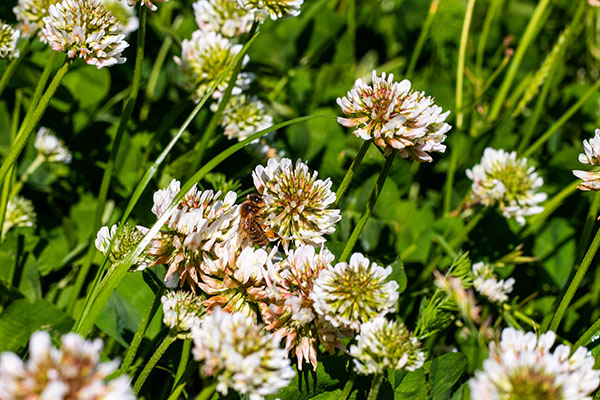
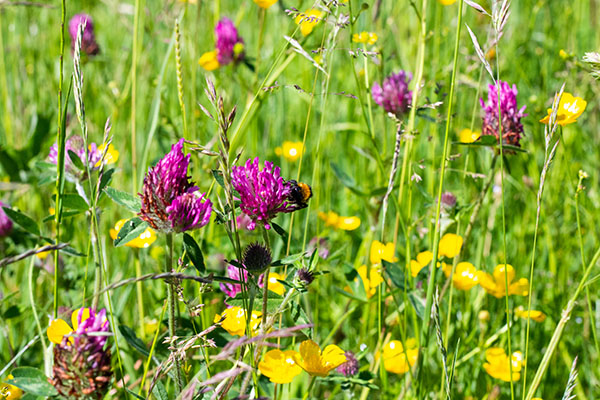
Common Knapweed
This purple flower looks very much like a thistle and is very common in our wildflower meadow margins. A favourite with butterflies, these flowers are often surrounded by Cabbage Whites and Meadow Browns!
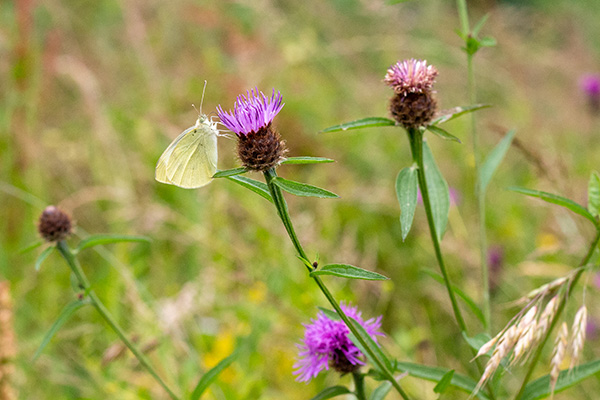
Tufted Vetch
These pretty violet flowers are a member of the pea family and flower from June to September. Also known as ‘cow vetch’ or ‘bird vetch’, it can be found in woodlands, grassland, and even coastal areas. When the seed pods are ripe, they turn black and have a similar shape to peapods.
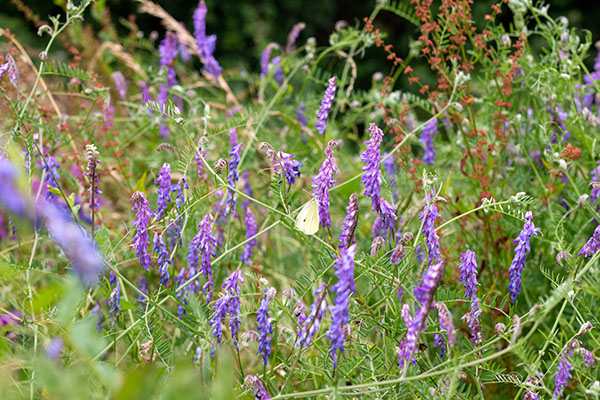
Sorrel
Commonly found in grasslands, woodland edges and roadside verges, as well as wildflower meadows, this delicate flower adds a sprinkling of bright crimson and pink throughout the green grasses. The arrow shaped leaves have a particularly tart taste, giving this plant its nickname of ‘sour ducks’.
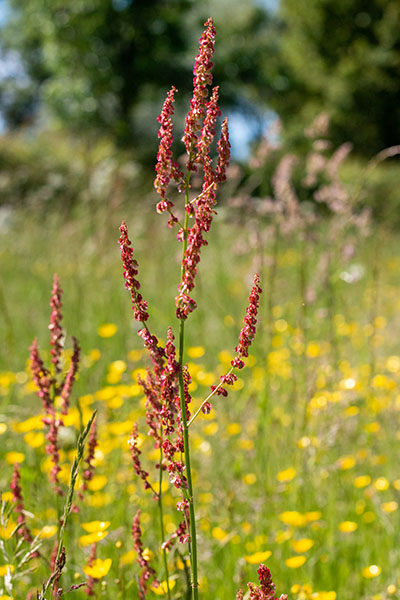
Cow Parsley
With umbrella-like clusters of white, frothy flowers, cow parsley grows very quickly in the summer before dying back. With large, flat umbrellas of small, white flowers and large, fern-like leaves, cow parsley stands out in a wildflower meadow. If you crush the leaves between your fingers, it will give out a very strong, aniseed scent.

Wild Carrot
Similar to cow parsley, wild carrot has umbrella-shaped flower heads, which start out red and bloom into white flowers from June to September. The leaves and roots of wild carrot smell just like the carrots we cook in our kitchens, but the roots do not form the big, orange vegetable we are familiar with. This plant particularly like chalky soils.
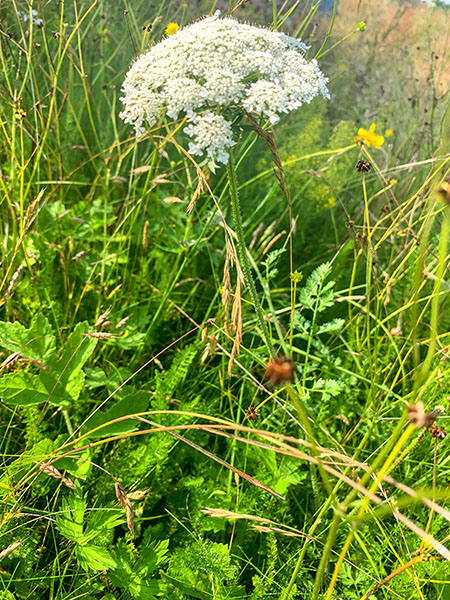
We are absolutely delighted to announce that we have won a prestigious Queen’s Award for Enterprise for Sustainable Development! Farrington’s Mellow Yellow is one of 205 organisations nationally to be granted an esteemed Queen’s Award for Enterprise in 2021 and one of only 17 to be recognised for our excellence in sustainable development.
We have been awarded a Queen’s Award for our industry leading approach to sustainability: from our commitment to carbon and plastic neutrality, to our LEAF (Linking Environment And Farming) Marque standards, to Duncan’s work monitoring and increasing the carbon stored in our soils.

“Winning a Queen’s Award for Enterprise is a huge honour, and being awarded it for sustainable development in particular is a real testament to our commitment to the environment! Sustainability is at the heart of everything we do and I am so proud to be recognised for our decades of hard work and dedication in this area.
Now more than ever, we all need to put our planet first, working towards a more sustainable future. I hope that seeing a small company from a village in Northamptonshire win such a prestigious award will encourage other small and medium sized businesses to take the next step in their sustainability journey, so we can all do our bit for the planet.”
– Duncan Farrington
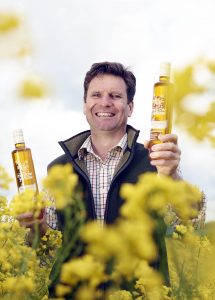
Now in its 55th year, the Queen’s Awards for Enterprise are the most prestigious business awards in the country. Following on from our award win, we will be continuing our sustainability work with Duncan involved in an EU funded project called AgricaptureCO2 working towards creating a globally recognised standard for measuring soil carbon content.
Learn more about how we look after the environment…
Carbon Neutral
We have measured, reduced and offset all of our carbon emissions and achieved the Carbon Neutral Gold Standard from the United Nations. We are also signatories of the United Nations Climate Neutral Now Initiative.
After reducing our carbon emissions through LEAF farming strategies, we offset our remaining carbon emissions by supporting reforestation initiatives and green energy schemes. This means that Farrington’s Mellow Yellow is not adding any emissions to our atmosphere.

Plastic Neutral
We have partnered with rePurpose Global, and we now fund the removal of the same amount of plastic from the environment as we use in all of our packaging.
This means that for every 1 kg of plastic in Farrington’s Mellow Yellow packaging, we fund the removal & recycling of 1 kg of plastic that would otherwise have been landfilled, flushed into our oceans or littered our environment.
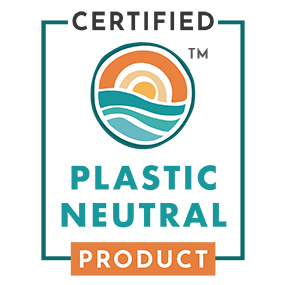
LEAF Marque
We are a LEAF (Linking Environment And Farming) Marque producer, this means we are at the forefront of environmentally aware agriculture.
LEAF encourages sustainable and environmentally responsible farming through a system called Integrated Farm Management. In simple terms, this means they encourage farmers to look at each part of their farm individually and ensure the whole farming process is environmentally sustainable.
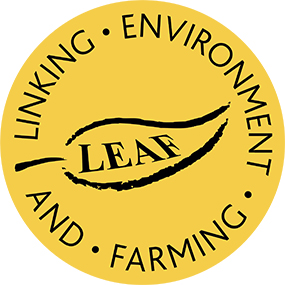
Soil Carbon Sequestration
Soil is a brilliantly effective carbon store. The world’s soils actually hold more than three times the amount of carbon than is in the atmosphere!
The process of soil storing carbon is called carbon sequestration and through our sustainable farming, we are storing a huge amount of carbon in our soils, stopping it being released into our atmosphere.
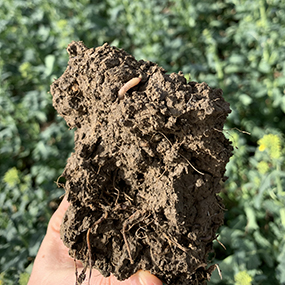
Solar Panels
We have installed solar panels on our barn roofs so that the power of the sun not only helps grow our crops, but now also helps power our oil presses.
Our solar panels can be found on two barn roofs, which are generating over half the total electricity we use at Bottom Farm in a completely renewable and environmentally friendly way!
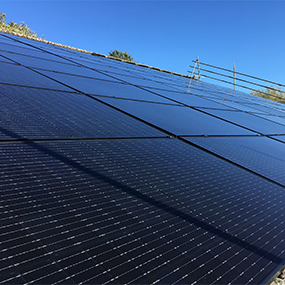
Tree Planting
Trees are fantastic for absorbing carbon dioxide from the atmosphere, providing shelter and homes for birds, insects and small mammals, and helping to reduce flooding and soil erosion.
Over the years, Duncan & his father have planted thousands of trees on our farm and last year we held a community tree planting event, getting a further 100 trees in the ground! Read more here.
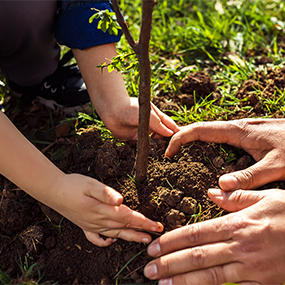
This year has been hard for everyone in many different ways, so as a business we have tried to help out charities, giving back wherever we can. All of these charities are doing fantastic work and we are so proud to be able to support them and the incredible work they do, so read on to learn more about them…
Faraway Children’s Charity
The Faraway Children’s Charity are a local, Northamptonshire based charity who help disadvantaged young children in need to survive, thrive and smile. They distribute resources such as toiletries, clothes, shoes, toys, games, books, Christmas presents, Easter eggs and food, as well as planning festive celebrations such as Christmas parties to provide fun and smiles.
Duncan & Eli have been supporters of the Faraway Children’s Charity for many years and as a business we usually donate Christmas gifts to the charity to distribute to local children that may otherwise not receive a gift during the festive period. This year we were also able to fund a number of Christmas parties put on by the Faraway Children’s Charity, helping to give the children something really exciting to look forward to.

Find out more about the Faraway Children’s Charity here: http://www.farawaychildrenscharity.com/index.html
Food4Heroes
When panic buying during the first wave of the COVID-19 pandemic left many key workers unable to purchase even basic foods such as fresh fruit and vegetables, many pubs, restaurants and food outlets who had closed their doors to customers wanted to show support for the NHS by providing cooked meals that staff could enjoy on a rare break, after their shift or take home. This outpouring of support led to the creation of Food4Heroes. The not-for-profit organisation brought together furloughed staff from caterers, pubs and restaurants to cook nutritious meals for NHS staff.
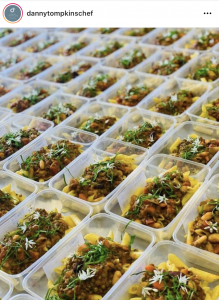
In Northamptonshire, chef Danny Tompkins joined Food4Heroes and was quickly cooking 250 meals a day for local NHS staff from Althorp House where the Earl & Countess Spencer gave him permission to use their kitchen for all the cooking. We were very pleased to be able to donate Mellow Yellow Rapeseed Oil to Danny for all his cooking and over a period of 40 days, Danny cooked a huge 10,000 meals for Northampton General Hospital staff.
Danny is still cooking for Food4Heroes using oil donated by us, now providing food banks across Northamptonshire with 550 meals every week!
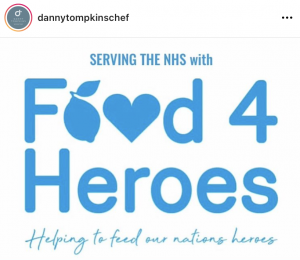
For more information on Food4Heroes, visit: https://food4heroes.org.uk/
FareShare – Fighting hunger, tackling food waste.
FareShare is a national charity that redistributes surplus food to almost 11,000 charities around the country that can turn it into meals. The food they redistribute goes to school breakfast clubs, older people’s lunch clubs, homeless shelters and community cafes. Every week, they provide enough food to create almost a million meals for vulnerable people.
Over the last 12 months, we have donated over 200 kgs of Farrington’s Mellow Yellow products. This was product that was too close to its best before date to send to shops, but still with plenty of life left for use. We hate the idea of food waste and so being able to send our surplus stock to FareShare has been fantastic as we know it is going to those in need and will be helping to fight hunger whilst also reducing food waste.
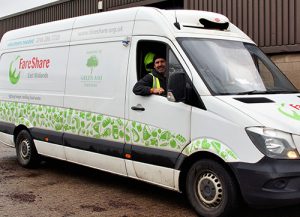
For more information on FareShare, visit their website here: https://fareshare.org.uk/
Mind – for better mental health
Mind is a mental health charity in England and Wales. Mind offers information, advice and support to anyone experiencing a mental health problem and lobbies government and local authorities on their behalf. Through helplines, community support, education and advice, Mind helps millions of people every year access the support they need to help them through any and all mental health problems.

In December we donated to Mind, helping to fund some of their work. Duncan was very keen to donate to a charity that supported those struggling with their mental health especially this year when the support given from organisations such as Mind have been absolutely critical.
For more information on Mind, visit: https://www.mind.org.uk/
Give Help Share
Give Help Share is a charity that was set up in 2020 by two teachers, Amanda & Jacqueline, to distribute food packages to families in need via schools and children’s centres in London and increasingly further afield. They are now supplying more than 2000 families every month. Amanda & Jacqueline wanted to put health and nature at the heart of their food packages so everything is healthy, nutritious and vegan. We have donated bottles of Mellow Yellow Rapeseed Oil as well as Mellow Yellow Chilli & Cumin Dressing to Give Help Share this year, which we really hope were enjoyed by the recipients.
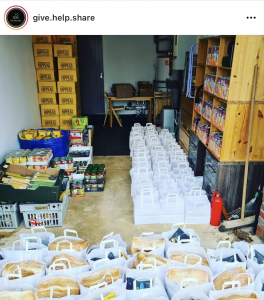
For more information on Give Help Share, visit https://www.givehelpshare.com/home
Nominate A Friend
Back in May, we most of our office was working from home, which allowed our production team and core office staff to remain on the farm producing food for you, safely. Everyone was finding it difficult to be isolated from our friends and families but we found that food and cooking bought us together, from afar. So we set up a giveaway of 20 Mellow Yellow gift sets. We asked our followers on social media to nominate a friend, family member or neighbour that they missed sharing a meal with to receive one of these gift sets.
We were overwhelmed by the incredible nominations we received. Hundreds of heartfelt messages about key workers, missed family members and friends and those going out of their way to support others. We randomly selected 20 winners and sent a Mellow Yellow gift set to their nominee.
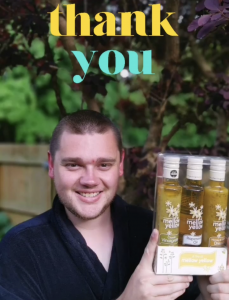
We absolutely loved being able to bring a little happiness to people’s day and found it incredibly inspiring to read all the nominations. We wrote a blog post with more detail which you can read here: https://www.farrington-oils.co.uk/heartfelt-isolation-nominations/
The environment is at the heart of everything we do here at Farrington’s Mellow Yellow and so it’s especially exciting when other companies focused on sustainability want to work with us! Fill Refill Co got in touch with us a while ago as they were looking for a local, eco-friendly, oil to use in a new soap product they were planning. After lots of work in their lab in Finedon (a stone’s throw from our farm), they have produced something really special!
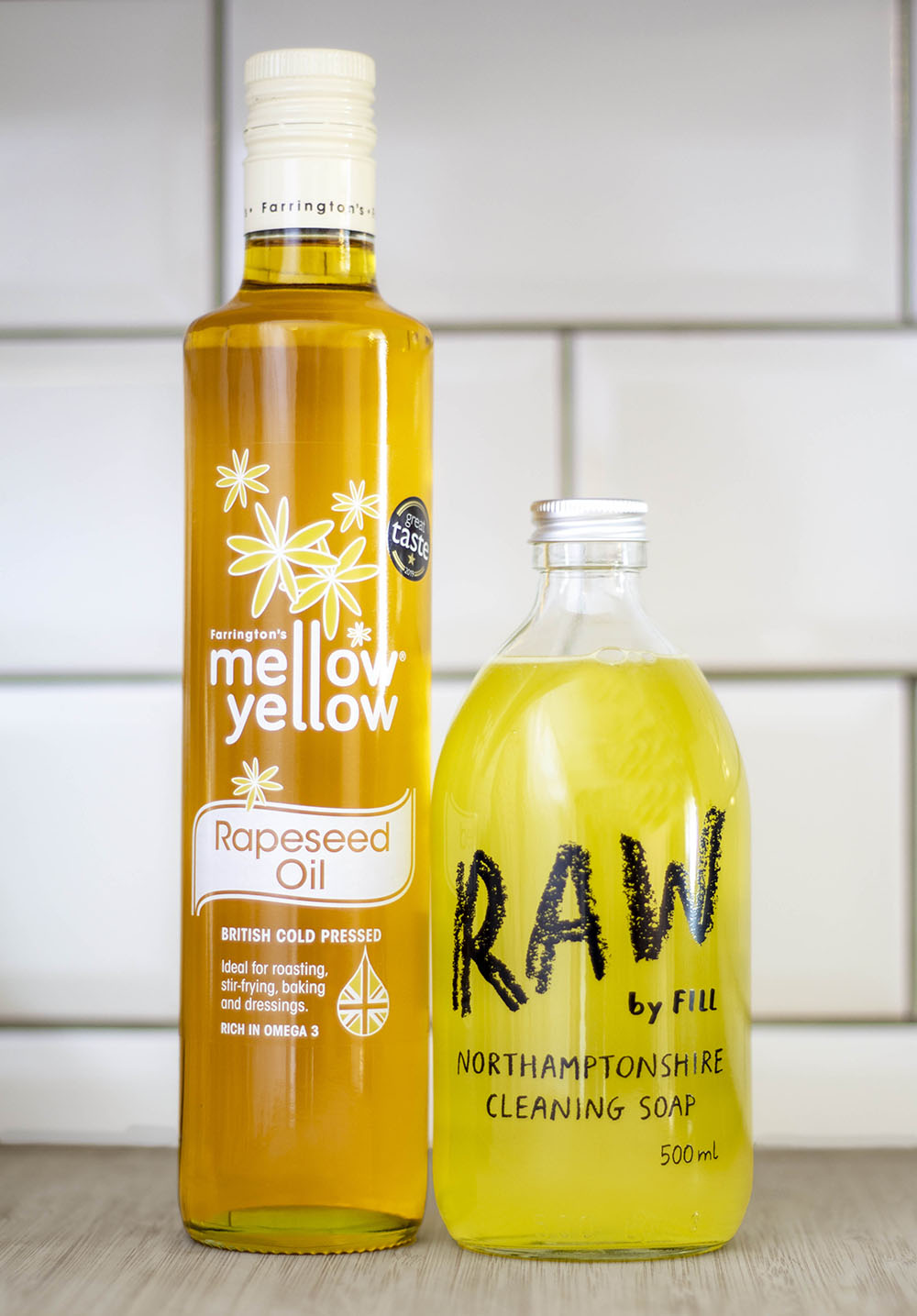
This month Fill Refill Co have launched their Northamptonshire cleaning soap which is made from our Mellow Yellow sustainably produced British cold pressed rapeseed oil. Given that we’re neighbours, both operating out of family-run businesses in Northamptonshire, and both sharing the same sustainability and eco-credentials, it made perfect sense to collaborate. We’ve caught up with Phil from Fill Refill Co to hear all about the new product…
“We wanted to make something from the most local ingredient we could find. Our factory in Northamptonshire is surrounded by golden rapeseed fields. We thought it would be cool to see if we could make a soap from it. We’d wanted to have a go at making Castile soap for a while, knowing that we used it at home and my wife wouldn’t use anything else to clean her make up brushes.
A while back we’d thought about shipping bulk olive oil from Cyprus (where my grandfather is from) or Crete (because their olive oil is pretty special) but rapeseed was growing all around us, so it just made sense and the proximity significantly reduces carbon footprint. Vicky & Alex did lots of work at the bench and we all took home a whole load of samples… we soon got to realise that it was making a really good alkaline cleaning soap, plus it had a lovely golden colour.
When we first went to visit Farrington’s we could see they were just as passionate as us about reducing plastic waste and we were so impressed with their site. They have a really nice set-up with a no-waste, carbon neutral production site, and all their crops are grown to LEAF Marque standards, a system designed to promote environmentally responsible and sustainable farming.
They quickly understood exactly what we were trying to do, so it was easy to get it rolling. Even better, we were able to get the rapeseed oil from them in a closed loop with bulk returnable packaging.”
Introducing Fill Refill Co’s Northamptonshire Cleaning Soap!
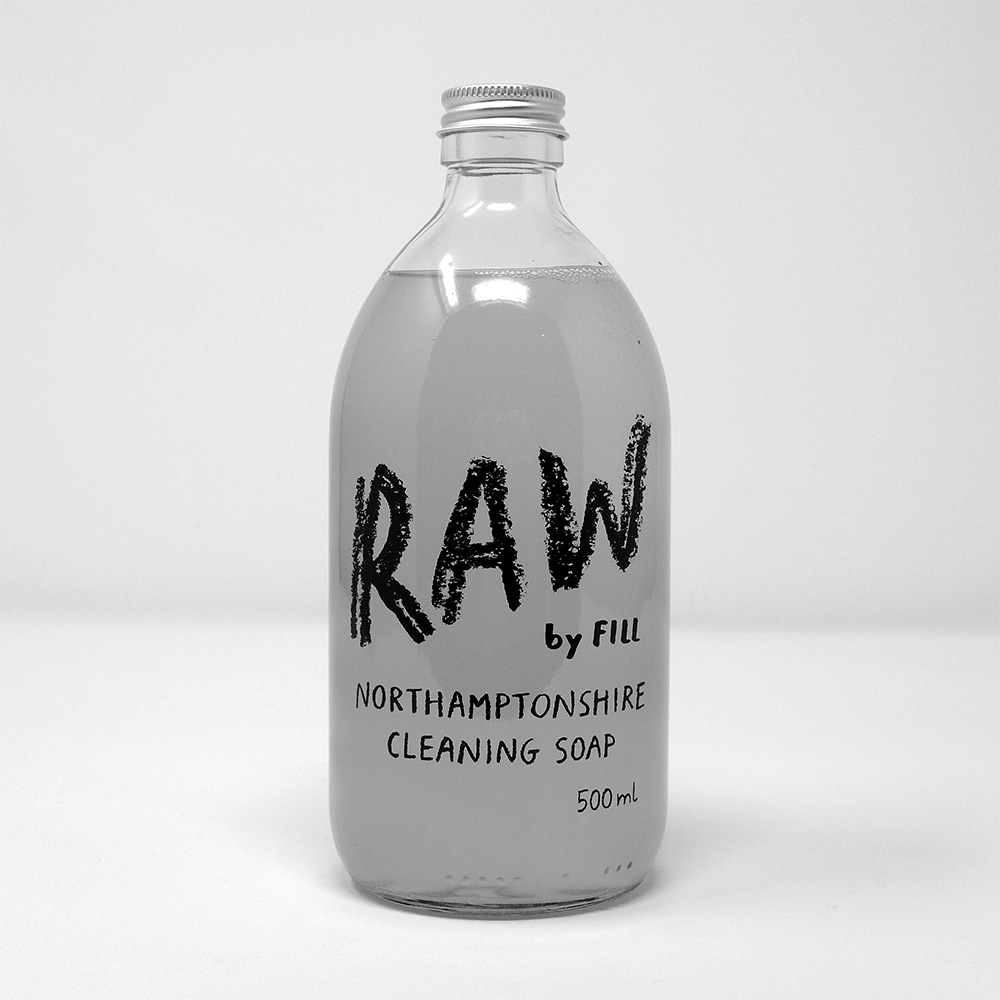
What is it?
An alkaline cleaning soap – pH 10!
What is it good for?
This stuff is versatile, it took us almost a year to perfect, but we don’t know of another rapeseed oil liquid soap out there that works like this. We think it’s good for making your own cleaning products, or for soft water laundry, degreasing, cleaning make-up brushes or paint brushes. It’ll help remove labels from jars, use as a soak for dirty delicates, or check out our recipe below for making the ultimate natural oven cleaner – just add salt, bicarb or the amazing Fill Scrub Powder.
Where does it come from?
Made from Farrington’s Mellow Yellow Cold Pressed Rapeseed Oil, grown just down the road from our factory, supplied in a closed loop, we turn it into bulk, plastic-free Northamptonshire liquid cleaning soap. We’re still finding out more things you can do with it!
What does closed loop mean?
Fill Refill Co are all about looking at ways to reduce and reuse. Whilst recycling might sometimes be the only option, we’re all about closing the loop wherever we can. Closed-loop supply simply put means circular, there is no waste, we just keep refilling, returning, refilling, returning – Fill, Clean, Repeat.

Like Farrington’s, the environment – and our impact on it – is at the heart of what we do. That and our passion for creating straightforward eco laundry and household cleaning products, that look cool, work great and reduce packaging waste.
Fill is for everyone who’s interested in a better way to clean. We make everything ourselves, in our factory, with real chemists combining biodegradable ingredients to create simple, modern and effective eco cleaning & laundry products. No dyes. No harsh chemicals. No plastic bottles. Less waste.
What to use your Northamptonshire Cleaning Soap for…
Cleaning Soap + Salt = Thick oven cleaner
Cleaning Soap + Bicarb = Slightly abrasive alkaline cleaning for cutting greasy deposits
Cleaning Soap + Scrub Powder (Clary Sage) = Removes burnt on dirt and debris
Find more cleaning recipes at https://www.falconenamelware.com/blogs/journal-entries/eco-cleaning-recipes-for-your-falcon
Check out the Northamptonshire Liquid Cleaning Soap from Fill Refill Co here and find your local stockist here.
A couple of weeks ago, Duncan Farrington was honoured to be included in the panel for the annual LEAF Conference. This is a showcase event normally held in the heart of the financial centre of London, bringing together LEAF members with their customers, journalists, international scientists and policy makers, to hear from speakers on the latest global sustainable issues of the day. This year was different as the conference had to take place online, yet it still was incredibly inspiring and allowed the panellists to share their sustainability goals for the future.
The conference was chaired by Tom Heap, BBC broadcaster with many years’ experience in agricultural journalism, and Duncan was joined by Minette Batters, chair of the National Farmers Union (NFU), Jonathan Wadsworth, lead climate change specialist at The World Bank and Chris Buss, deputy director of the International Union for Conservation of Nature (IUCN) Global Forest and Climate Change Programme.
Each of the panellists shared their sustainability stories, goals and wishes for the future. Here is what each one said, which you can watch via video if you prefer.
Duncan Farrington:
I am very proud that Farrington’s Mellow Yellow is the first food brand in the world to be certified as both carbon and plastic neutral. Having been a LEAF Marque farmer for many years, we are used to collecting data on such things as energy use, which is very helpful as a management tool, but I felt we could use this information as the basis of something bigger and importantly commercially rewarding which led to us becoming carbon neutral.
Through small changes, we have made big differences to our carbon emissions. By reducing the intensity of cultivation on the farm, our fuel usage has reduced 60% to 75%, a broader crop rotation has reduced nitrogen fertiliser usage by 13% and solar panels on our barn roofs generate 50% of our electricity. But the biggest gain has been in soil health from the sustainable techniques I have been practising for the last 22 plus years. I have shown through ongoing soil analysis how a particular field’s general soil health has improved, including soil organic matter which has increased by 75%. The net result has been the absorption of an estimated 300 tons of CO2 by one field alone every year. To put this into context, the total net CO2 removal on our farm is enough to off-set the emissions from around 2,400 Mellow Yellow Minis from UK roads each year. So sustainable agricultural soil management has a huge potential positive influence on climate change.
LEAF already do fantastic work as the trusted go-to organisation supporting sustainable food production and there is now an increasing commercial appetite for climate friendly food that LEAF can lead as a consumer facing organisation. This will drive the commercial success of LEAF farmers and growers, which in turn will deliver the step change in innovation and ambition required. Imagine the kudos and effect if LEAF was successful in winning an award from the Duke and Duchess of Cambridge’s Earthshot prize for championing a carbon friendly food system. That would drive real ambition!
My one climate change wish in the near future is to get an internationally accepted certification for soil organic matter. I am involved in an EU consortium hoping to look at how soils can be accurately evaluated on mass scale using satellite data for their soil carbon content. The ambition is to create a trusted certification, to help land managers explore how their actions can affect soil health, creating the financial and moral incentive to manage land in ways to drive the huge potential of carbon sequestration.
Minette Batters:
The game changer for government and political thinking around climate change is COP26. Farming has seen huge impact from ever more severe weather and farmers are already experiencing the impact of climate change. The NFU has set an ambitious target of net zero by 2040 because we really believe farmers can achieve this with the right incentives. We need to focus on more efficient and sustainable farming, and nobody has shown more leadership in this area than LEAF.
We also need to focus on more carbon storage. There is research into beetle banks that is interesting for example. There is a huge amount that can be done by farmers in carbon storage and this is key. Renewable energy is another big area of opportunity. It is incredibly important for a farm’s diversification to look into renewable energy.
There are a lot of challenges around diet. We need to engage with whole foods and nutrition, cooking from scratch and realising that health is dependent on our diet. We need to look at what we aren’t consuming that we can export too. We also need to revolutionise how we think about water. We need to move water around the country rather than letting diffuse water run into the sea. This needs a strong and ambitious working relationship with government.
My one climate change wish is that COP26 is a game changer, that agriculture rises to the fore across the world and we work together to ensure we are deemed an important part of the solution. Climate change is the challenge of our time and I passionately believe our farmers are the solution.
Jonathan Wadsworth:
The World Bank is an international development organisation with a role to reduce poverty and inequality by lending money to governments of poor countries to improve their economy and standard of living. Over the next 5 years, it will invest $200 billion in climate adaption and mitigation projects.
Progress has been uneven across regions and countries. Millions of people are being left behind, climate change exacerbates these inequalities. The poorest and most vulnerable are hardest hit. To have any hope of achieving sustainable development goals by 2030 we must adapt quickly to climate change and reduce emissions, with urgency. The greatest climate challenge at the moment is how to take action now.
The world food system does an amazing job. For the past 50 years, food production has outpaced population growth, adding $8 trillion a year to global GDP. If the food system was a country, it would have the third largest GDP in the world, behind China and the USA. But this performance comes at a high cost to people and the planet.
Our food system is both a victim and a culprit of climate change, but with the right incentives, approaches and innovations, we know it can be a big part of the solution. The good news is that more and more people are becoming more aware and starting to take action.
LEAF is an excellent example of farmers and researchers working together to find and promote climate-smart solutions. This approach merits being massively scaled up to become a real movement of change and the UK could play a major role.
Agriculture is the only sector able to capture carbon from the atmosphere and store it naturally in vast amounts. We must exploit that advantage fully.
The global food and agriculture system needs to deliver three main things:
– To reduce emissions that contribute at least 30% of the mitigation needed set out by the Paris Agreement.
– Widespread adoption of the planetary human health diet.
– More inclusive development
LEAF can play a key role in continuing to demonstrate what can be achieved and influence governments and investors to find the financial and the political will to support and facilitate a great agriculture and food system transformation.
If I had one climate change wish it would be that COP26 is a success and world governments would recognise that food and agriculture is indispensable for addressing the climate emergency.
Chris Buss:
I work around nature-based solutions and land use and protection of nature, restoration of nature and land production systems. Trees are key for farming systems; they bring nutrients into farming systems, regulate water, provide building materials and firewood. It is a win-win system so makes sense to bring trees into farming.
A great example of the role of nature is pollination. The loss of pollinators is estimated to have a net value of $150 billion to $160 billion. There is a loss to consumers by increased prices, but also a loss of profit to farmers too as they have to replace natural systems.
Success for nature would be farmers helping to make and shape policy. As they manage the land, they are closest to nature and are the key partners globally to help integrate nature into our agricultural systems and shape policies to make sure nature is included in their farming strategies.
One successful strategy that we are building with farmers globally, is working to restore land on-farm and off-farm, bringing trees back into the farming systems. This is critical as it provides farmers with more resilient land use systems, secures supply, sequesters carbon and is socially just.
Moving forward, technical support can be provided to farmers, support can be provided to decision makers going into climate change negotiations and we can build land restoration strategies.
LEAF’s 10 Year Strategy
After a lively Q&A session with Tom Heap, LEAF Chairman Philip Wynn and LEAF Chief Executive Caroline Drummond shared the new LEAF 10 Year Strategy. This is a continuation of their work in developing and promoting more sustainable agriculture through Integrated Farm Management. They are going to support the delivery of positive action for climate, nature, economy and society based on their core work and the principles of circular agriculture.
Their vision:
A global farming and food system that delivers climate positive action, builds resilience and supports the health, diversity and enrichment of food, farms, the environment and society.
The mission:
To inspire and enable more circular approaches to farming and food systems through integrated, regenerative and vibrant nature-based solutions, that deliver productivity and prosperity among farmers, enriches the environment and positively engages young people and wider society.
Their 2031 ambition:
LEAF’s ambition is to play a demonstrable part in transforming farming and food systems. Building on their work since LEAF was established in 1991, this will be through the agro-ecological and regenerative benefits of the whole farm, site specific focus of Integrated Farm Management to drive positive action for climate, nature, economy and society. Embracing circular agriculture with health, diversity and enrichment at the centre of all they do. Through the use of management tools, the harmonisation of metrics, technology, innovations, data and Artificial Intelligence, training, research, demonstration, market opportunity, education and engagement, they will support and contribute to the practical delivery of national and global commitment. This will include the Sustainable Development Goals (SDGs), the Paris Agreement and the Post-2020 Biodiversity Framework.
You can read the full plan here or watch this short video:
We’re so pleased to present Pestle Curry Pastes, a brand new brand that uses Mellow Yellow Rapeseed Oil as a key ingredient! We chatted to Neha, the founder of Pestle, about this exciting new venture…
First up, introduce yourself and your products!
Hi, I’m Neha Hampton, I’m a chef based in Sussex and I’m excited to share my new brand, Pestle. Pestle is a range of hand crafted curry pastes blended to capture the flavours of some our favourite dishes. This brand is not just about great food, it’s a journey of exploration fuelled by curiosity to look beyond what we know to uncover the stories of history, people and places with the aim to promote cultural unity.
How did Pestle start?
This year has presented us with many challenges and changed everything we know and love. Motivated by my desire to connect with people and share my love for food, I decided to turn a hobby of making fresh curry pastes into a small business. It all started in my local community and with a outpouring of support I decided to make it official and that’s how Pestle was born.
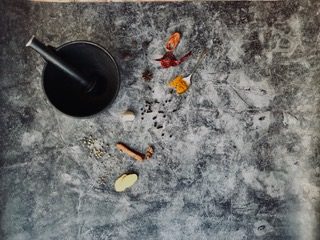
We’re so pleased to be used in your curry pastes. How did you first hear of Mellow Yellow and why did you choose to include us in your pastes?
I’ve been a fan and have used Mellow Yellow in my home for many years now – I love the slightly nutty flavour and the versatility with so many different cuisines. A lot of Indian curries involve slowly caramelising onions, garlic and ginger as a base and an oil with a high smoke point works best for this… Mellow Yellow is perfect and the colour reminds me of the mustard oil that my mum used to cook with. To say I was delighted to find out that it was available in larger quantities for businesses like mine is an understatement!
Your first range of curry pastes is called ‘Behind the British Curry’, can you tell us about the history of a curry in the range?
The love for curry weaves through many generations and Indian cuisine has firmly made it into the hearts and onto the plates of Britain.
The ‘Behind the British Curry’ range shares stories & flavours of the ancestral heritage of some of our favourite dishes. Vindaloo for example, is Goa’s most famous export… its origins however trace back to Portuguese traders in the 15th century who carried with them a dish called carne vinha d’alhos, pork marinaded in garlic and vinegar for their long journeys. The dish was adapted in Goa to local conditions and with no vinegar, they used palm wine and added local ingredients like tamarind, pepper & cinnamon. Chillies in fact arrived with Vasco De Gama in 1498 and eventually replaced or complimented black pepper as a source of heat in Goan cuisine.

How are your pastes made?
There’s essentially 3 stages – the first is caramelising onions, garlic and ginger in Farrington’s Mellow Yellow Cold Pressed Rapeseed Oil, the second is roasting and grinding my unique blend of spices and the third is bringing these together to form a paste. The aim is to make the cooking process for the customer simple and easy – you just add in a few ingredients, cook and voila, a super tasty meal.
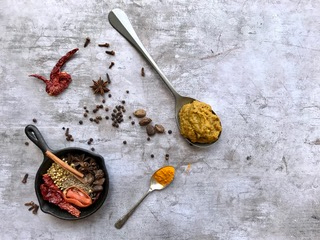
We know the quality ingredients are important to you, other than our oil, can you tell us about any other special ingredients used?
Spices are a real foundation to my pastes and are an important part of the culinary heritage that we share all over the world. When developing my recipes I reflect on my travels & my own experiences of these dishes and I am looking to create as near to those moments as possible. This means creating the perfect balance and blend of spices and when developing recipes, literally adjusting each peppercorn up and down to get them perfect.
We love the packaging of your products, what inspired these beautiful designs?
One of the pillars of the brand is the idea of ‘handmade’ so when it came to packaging I wanted to follow that theme. I wanted this to feel like something you could grow, like a packet of seeds and hence the envelope. The hand drawn illustrations are by a friend Mel @smithandwonder and we worked together to capture the essence of the Pestle and ingredients that go into each paste.
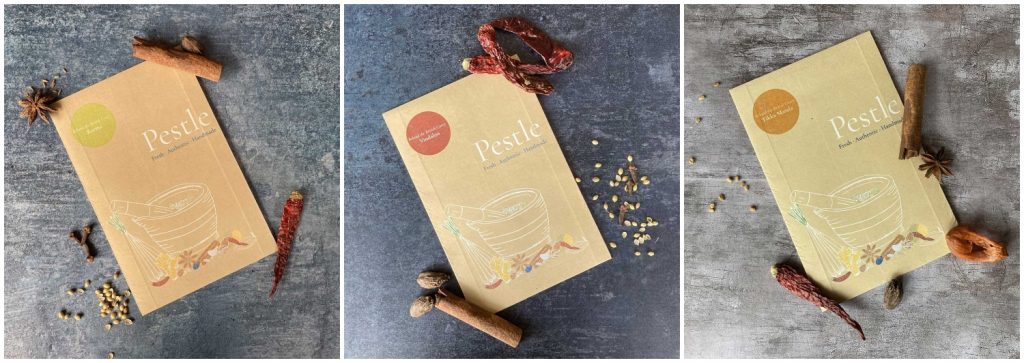
What is your favourite dish to cook (not including your own curry pastes)?
Wow, what a big question. As a fully obsessive foodie, I love cooking is every shape or form, from baking to making an omelette to elaborate fine dining. One of my favourite dishes to cook and eat is Bebek Betutu – a Balinese duck dish, which is covered in a spice paste and roasted for 4-6 hours at a low heat. I recently added in Farrington’s Mellow Yellow Oak Smoked Rapeseed Oil which adds the flavour and memory of the duck being slow cooked over a wood fire in Bali.
Where can we find your products and where can we follow you on social media?
You’ll find me on the socials @pestleltd – here you’ll see my journey of food and stories of people, places and history.
I recently launched with my first online retailer, The Ethical Butcher – you can buy pastes and meal kits where the pastes have been paired with incredible meats to give you a simple, easy and tasty meals at home. More retailers announcing very soon!
What’s coming next for Pestle?
This is my chapter 1 and so today I am focussed on expanding the brand and retailers. As the journey unfolds, I will be looking to expand production in my new studio kitchen and I’ve even started research and development for the next range of products. Watch this space 🙂
To buy Pestle curry pastes, visit The Ethical Butcher here.
Follow Neha on Instagram and Facebook.
The environment has always been at the heart of everything we do and we are so proud to be officially certified by the United Nations as carbon neutral, highlighting our commitment to sustainability.
What is carbon neutral?
Carbon neutral means achieving net zero carbon dioxide emissions by balancing carbon emissions with carbon removal (often through carbon offsets).
Many large companies and even governments have set carbon neutral goals, typically to achieve carbon neutrality within 10, 20 or even 30 years. Amazon have pledged to be carbon neutral by 2040, the UK government has said they aim to reach this milestone by 2050 and Delta, an American company, have pledged to become the first carbon neutral airline in the next 10 years.
All of these companies have given themselves plenty of time, which can be needed for big corporations. However, we knew that something needed to be done sooner than this. Thanks to our LEAF Marque audits, we have been monitoring our emissions for many years so were in a great position to become carbon neutral a lot sooner. Read on to find out how we became carbon neutral…
How did we become carbon neutral?
The first step was measure. This involved us looking at every part of our business, from each employee’s commute to work, to the amount of electricity used in our office and factory, to the fertiliser used on our fields. We calculated the greenhouse gas emissions from each and this gave us our carbon footprint.
We then signed up to the United Nations Climate Neutral Now Initiative Pledge. This pledge showed our commitment to measure, reduce and offset our carbon emissions. This pledge has been signed by many other companies and governments that are prioritising our environment and making a meaningful difference.
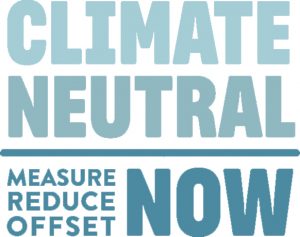
After measure, the next step was reduce. We are constantly working to reduce our emissions and through our LEAF farming practises, we are able to accurately measure this and continue to reduce them. Some of the ways we have reduced our emissions are:
– The installation of solar panels on our barn roofs in 2018 which now produce 50% of our total yearly electricity. In the summer months, we are producing a huge 80% of our electricity from the solar panels!
– We have dramatically reduced our fuel usage on the farm by stopping ploughing in 1998 and since then, have continued to reduce this further by using less fertiliser on our fields as the soil health increases and provides more nutrients to the crops. As well as reducing fuel usage, by stopping ploughing, we are actually locking in huge amounts of carbon dioxide into the soil, you can read more about this here.
– We use GPS systems on all our tractors to make them as efficient as possible, lowering our fuel usage and keeping emissions to a minimum.
– We use LED energy saving bulbs and timers on our lights to keep our electricity usage as low as possible too.
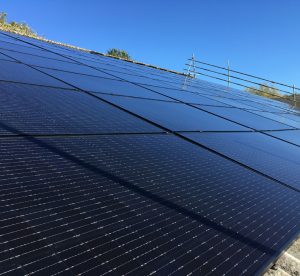
As we are a LEAF farm, we have a yearly audit to ensure we are doing the best to farm in harmony with nature, and we are always working to find new ways to reduce our emissions and our impact on nature!
The next step in our carbon neutral journey was to offset our remaining emissions. We used United Nations approved offsets and have been able to support a reforestation initiative in Uruguay and a United Nations clean energy project.
With this last step completed, we became certified as carbon neutral in January 2020 and received the Carbon Neutral Gold Standard from the United Nations!

What’s next?
Becoming carbon neutral is a fantastic achievement, but we aren’t going to stop there. We aim to be carbon negative, that means we will be absorbing more carbon from the atmosphere than we put into it, so we would be removing carbon rather than adding it.
In order to become officially certified as carbon neutral, we had to use the United Nation’s way of calculating net carbon emissions. this unfortunately meant we could not take into account all the incredible work we do with our soils as the carbon stored in soils is not yet officially recognised as a carbon store. From our own calculations, if this was taken into account, we would already be carbon negative!
Duncan is now involved in European project to find an internationally accepted, verifiable and certifiable method of measuring soil organic content on a continental scale, encouraging farmers and land managers to adopt carbon capturing methods improve their soil carbon content. The project aims to empower farmers to become agents of climate mitigation, where soil carbon and health will become a financial asset for the farmer and provide natural capital for the wider society by reducing global carbon emissions.
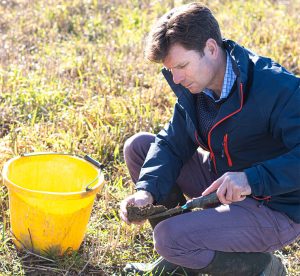
Every year at the start of August, farmers are encouraged to share their day online as part of 24 Hours in Farming #Farm24. We took part again this year and shared all the goings on from Bottom Farm.
First, we headed out to find Marvin cultivating. This field was growing wheat this year which has now been harvested, we leave the wheat stubble in the field to biodegrade and nourish the soil. We are planning on planting beans in this field in October and beans need to be planted quite deep into the ground. Marvin has to cultivate the soil to loosen the top layer to make it possible for us to plant the beans. This is a big field and the cultivator needs to be driven quite slowly so this will take the majority of the day!
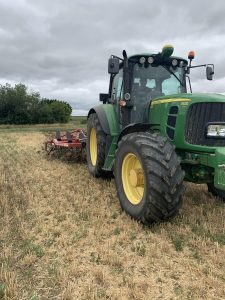
We then headed back to the farm yard, passing the combine harvester which is having a rest until the spring barley is ready to be harvested.
![]()

Here are the wild flowers we have growing around our spring barley. These flowers provide habitats for insects and is great for pollinators.
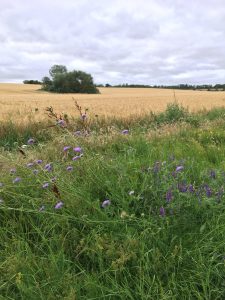
We even have these beautiful daisies in the wildflower meadow margins, and Duncan explained these are actually chamomile for making into tea!
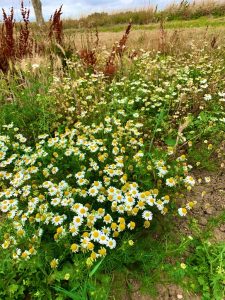
The last stop on our way back to the farmyard was these trees. Duncan planted them back in 1989 and they are just a few of the 8000 trees he has planted on the farm over the years.
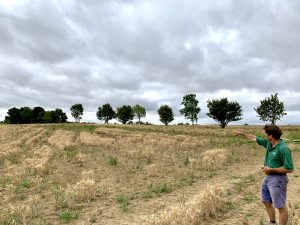
Heading into our rapeseed oil production area, we watched the team pressing and bottling our Mellow Yellow Rapeseed Oil. We cold press our rapeseed on our farm. Our presses run 24/7 to produce Mellow Yellow Rapeseed Oil for kitchens up and down the country! We call it the process of no process. Simply sow, grow, press and bottle!
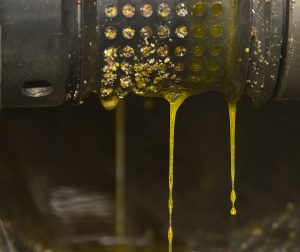
We harvested our rapeseed a few weeks ago and this what the little seeds look like. They’re bright yellow inside and packed full of delicious and nutritious oil!
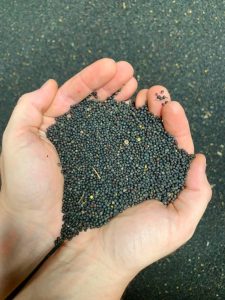
After lunch, Duncan headed out to do some mowing. Tidying up the edges of fields already combined and making sure the various public footpaths we have going through the farm are clear and accessible for people on their daily walks!
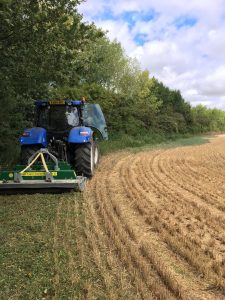
Before we harvest the wheat, we need to check the moisture content, still a few more days of sunshine needed for this field! Duncan is winnowing here – blowing air through the wheat to remove the chaff!
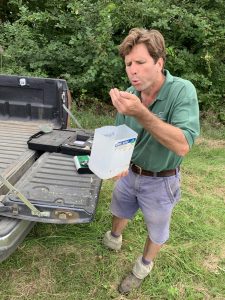
We then left Marvin finishing off the cultivating and that was our day!
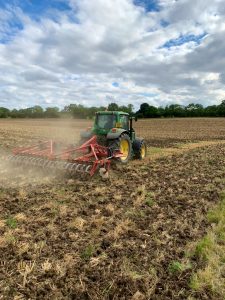
We had a great time sharing our day on the farm and we hope you enjoyed getting an insight into British farming! See you next year!
This month is #PlasticFreeJuly and we thought it was the perfect opportunity to share our plastic neutral story…
The environment has always been at the heart of everything we do and earlier this year we took the next step in our sustainability journey and became plastic neutral! Don’t worry if you don’t know exactly what this means, read on and we’ll explain.
Becoming plastic neutral is a lot like becoming carbon neutral which is more commonly understood (and something we have also achieved, read more here) but the general idea is that we now fund the removal of the same amount of plastic from the environment as we use in our packaging, meaning Farrington’s Mellow Yellow is certified as plastic neutral.
MEASURE
The first step in becoming plastic neutral was to measure our plastic footprint. We looked at our products and how they are sent out and started listing all the plastic used at each stage. As our bottles are glass with a metal cap, there isn’t a huge amount of plastic on the product itself, but, for example, the label is plastic, as is the little pourer inside our cap. We also had to look at the way we send out our products. When sending large quantities of our glass bottles to supermarkets, we have to wrap each pallet in plastic wrap to stop breakages which would lead to food waste, so this plastic had to be counted.
Once we had a list of all the plastic used, we worked out how much each item weighed and how much of it we use in a year, and this created our yearly plastic footprint. With this figure, we had a really accurate representation of the amount of plastic that we, as a company, are putting into the environment each year. This is our plastic footprint.
OFFSET
Once we had our plastic footprint, we got in touch with rePurpose Global. rePurpose Global are a global community of conscious consumers and business that are committed to taking action against climate change.
rePurpose partnered us with a recycling project in India so that we could directly fund the removal of the equivalent weight of plastic as our plastic footprint.

rePurpose work with vetted recycling projects tackling the waste crisis in India. A lot of the plastic they are removing from the environment is typically low-value plastic, which recyclers don’t often want to collect as it doesn’t bring them as much money. However, this plastic (such as crisps and chocolate wrappers) is incredibly polluting, especially when it reaches our oceans. rePurpose enables the ethical collection and recycling of this plastic, paying the waste workers a fair wage and giving them proper employment opportunities.
We are tackling a global issue, a lot of the UK’s waste is unfortunately exported to developing countries where it is sent to landfill or ends up in our oceans, so working with rePurpose is helping to finance crucial recycling infrastructure and improving wages and working conditions of waste pickers in India.

REDUCE
The next step is to gradually reduce our plastic footprint year on year. We are deeply committed to sustainability, so are searching for the most environmentally friendly options for our packaging. We know that sometimes removing plastic and replacing it with other materials isn’t always ultimately the best option for the planet. For example, plastic bags have the lowest carbon footprint of shopping bags, as long as they are reused many times, whereas a paper bag requires more energy to produce and isn’t as reusable. So when we look at reducing our plastic footprint, it is incredibly important to us that all environmental aspects are considered and the best option is chosen. We are working hard to find the best solutions, so make sure to keep reading our blog posts for more updates!
If you would like to work out your own plastic footprint, rePurpose have a simple calculator for you here and even have options for individuals to offset their personal footprints and become plastic neutral.

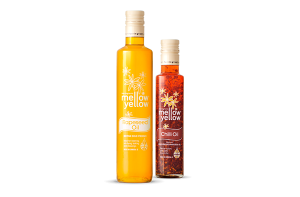 Oils
Oils Rapeseed Oil
Rapeseed Oil Chili Oil
Chili Oil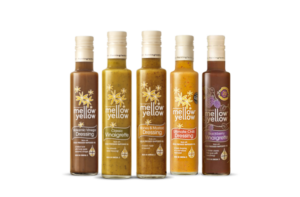 Dressings
Dressings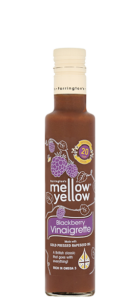 Blackberry Vinaigrette
Blackberry Vinaigrette Classic Vinaigrette
Classic Vinaigrette Balsamic Dressing
Balsamic Dressing Honey & Mustard
Honey & Mustard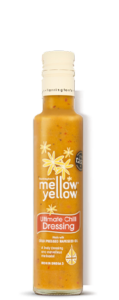 Ultimate Chilli Dressing
Ultimate Chilli Dressing